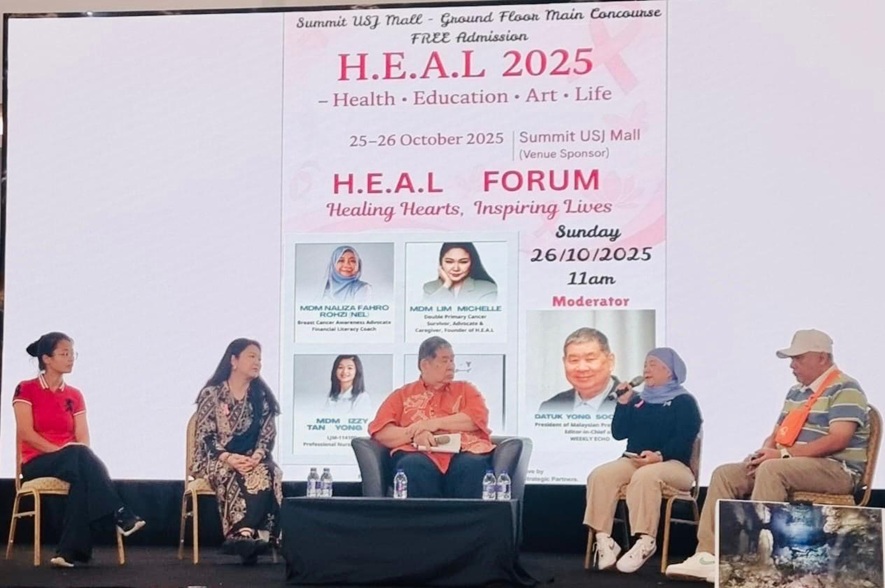
The Panel Discussion on Cancer at the H.E.A.L. Forum 2025, with from left Izzy Tan, Michelle Lim, Yong Soo Heong (moderator), Naliza Fahro Rozi & Shaharruddin Rosli
While world leaders debated protracted peace deals and trade pacts at the KLCC in Kuala Lumpur on a bright Sunday morning on Oct 26, 2025, a quieter but no less powerful movement stirred at USJ Summit Mall in Subang Jaya, Selangor.
At the H.E.A.L. (Health, Education, Art & Life) Forum, cancer survivors, caregivers, and healthcare advocates gathered not just to share poignant and moving stories but to spark a workable solution.
From the forum’s theme “Healing Hearts, Inspiring Lives”, they came up with an inspiring proposal: Have a sizeable, sustainably-managed fund — possibly fuelled by a specially-run lottery or from civic contributions — to ensure that no Malaysian cancer patient is ever left in the lurch when it comes to treatment access.
The Human Cost of Cancer
Michelle Lim Geok Kiang, a cancer survivor, shared how insurance saved her life and learnt that disaster can strike without warning.
Naliza Fahro Rozi (Nel), another survivor, spoke of friends who faded away simply because they couldn’t afford to continue treatment.
Shaharruddin Rosli, Nel’s husband and primary caregiver to her, echoed the sentiment: “You need money to stay healthy. Constant care is not optional — it’s survival.”
Having adequate funds from a lottery-funded trust or endowment will mean that patients do not have to delay chemo or skip scans because they’re choosing between medicine and groceries.
The Proposal: A Cancer Care Fund for All
The idea is simple but powerful: pool resources through a transparent, well-managed fund — possibly via a national lottery, corporate CSR, or donations. The fund should aim to:
• Cover treatment gaps for uninsured or underinsured patients
• Support palliative and home care services
• Invest in early detection and community outreach
• Be governed by a multi-stakeholder board of integrity, including survivors, medical professionals, and civic leaders
This isn’t charity — it’s civic infrastructure. Just as we build roads and schools, we must build pathways to healing.
Why a Lottery?
Lotteries, when ethically run and transparently audited, have funded hospitals, education, and disaster relief in many countries. A cancer care lottery could:
• Engage the public in a cause that touches every family
• Create a steady revenue stream without burdening taxpayers
• Normalise conversations around cancer and care
A Shining Malaysian Model for the World?
Malaysia has long been a leader in multiracial unity and community-driven solutions. This fund could be a model for other countries as well — a testament to how civic compassion can be institutionalised. Imagine a future where no one delays treatment because of cost. Where caregivers like Shaharruddin are supported, not stretched. Where forums like H.E.A.L. become launchpads for policy, not just panels of pain.
What’s Next?
The lottery funding proposal now needs champions — policymakers, philanthropists, insurers, and everyday Malaysians. It needs a pilot, a framework, and a public conversation.
As Michelle said, “I didn’t think I’d need insurance. Until I did.” Let’s not wait until it’s too late — for someone else.
The forum, organised by Forte Resources Consultancy PLT, whose Founder and Chairperson is Michelle, also displayed several art pieces by cancer patients.
Izzy Tan Yong Yi, a private palliative care and emergency response nurse, said art was a healthy form of therapy for them as it helps to calm them down of their anxieties.
“Sometimes after painting or drawing, they are more relaxed and could eventually be more open to talk about their state of health to their loved ones or close friends,” she said.
Dabbling in art can help patients take away the emotional stress in their lives, said Michelle, adding that this was why Forte Resources chose to highlight this aspect of patient therapy.
It has been found that art therapy allows patients to express complex emotions — fear, grief, hope, anger — without needing words. This release can be deeply cathartic or liberating.
Studies show that engaging in creative activities like painting, drawing, or sculpting helps lower cortisol (stress hormone) levels and reduce anxiety during treatment. A 2020 pilot study found that cancer patients undergoing chemotherapy experienced measurable improvements in psychological distress after participating in art therapy sessions.
Other programmes at the two-day H.E.A.L. Forum, which began on Oct 25, included a “Family Fashion Walk” by members of Sedar Autism, an NGO dedicated to autistic children, and discussions on beauty, mental health through art and ocean conservation and Peranakan culture.
Michelle, who plans to organise H.E.A.L.2026 next year, said the depth of the conversation and the sincerity shared among the speakers and guests left a lasting impression on everyone present. “The forum was not defined by numbers, but by the power of its message — that healing begins with compassion, understanding, and the courage to speak from the heart,” she said.
WE